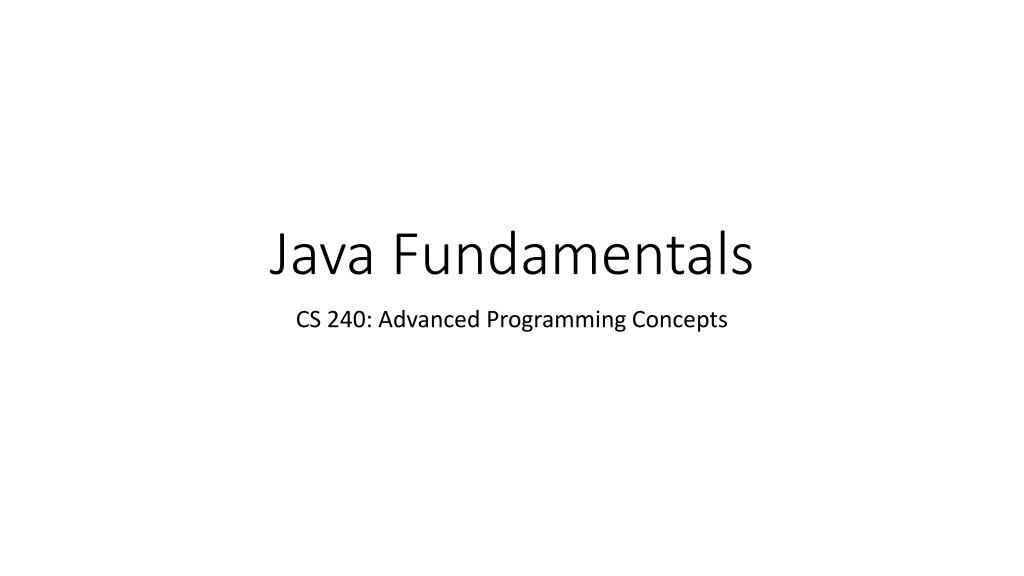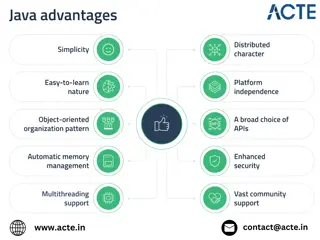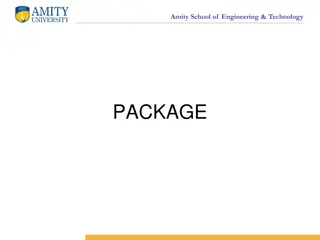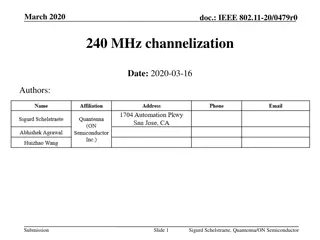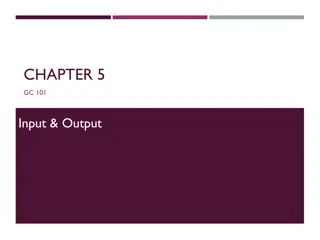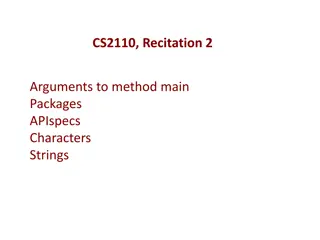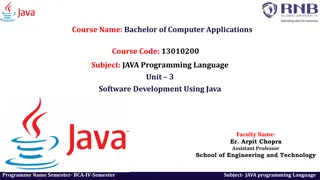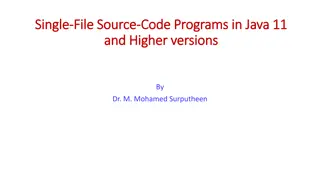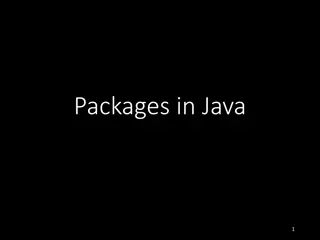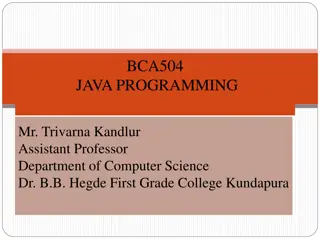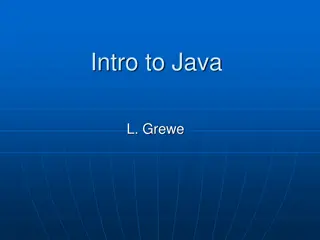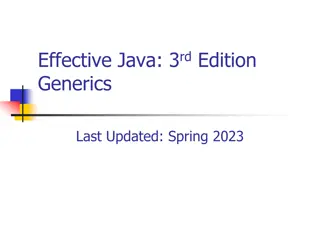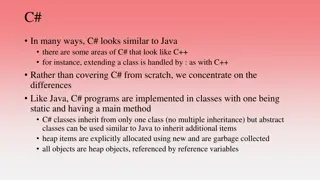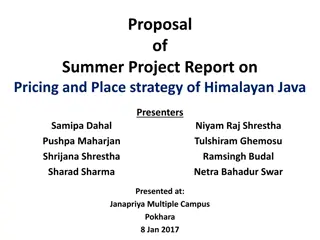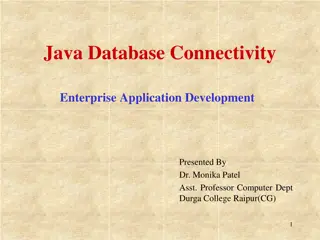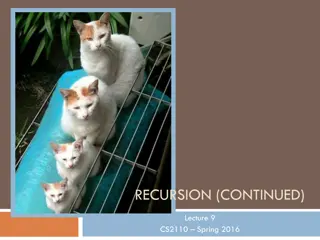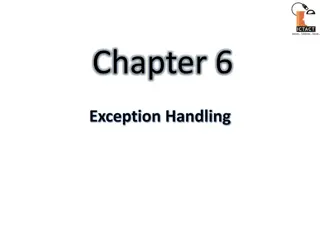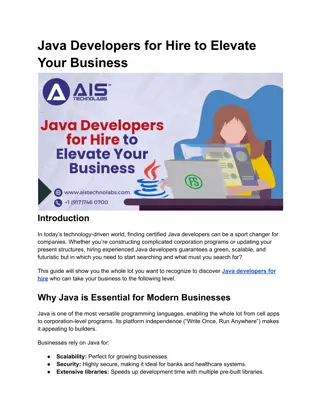Java Fundamentals CS 240 Overview
In this overview, delve into the fundamentals of Java programming, covering its origins, key concepts, differences from C++, installation steps, popular IDEs, and more. Explore the evolution of Java from its inception at Sun Microsystems to its current status as a versatile and widely-used language. Discover the essential characteristics that make Java a robust, secure, and high-performance programming language, with a focus on object-oriented principles and portability.
Download Presentation

Please find below an Image/Link to download the presentation.
The content on the website is provided AS IS for your information and personal use only. It may not be sold, licensed, or shared on other websites without obtaining consent from the author.If you encounter any issues during the download, it is possible that the publisher has removed the file from their server.
You are allowed to download the files provided on this website for personal or commercial use, subject to the condition that they are used lawfully. All files are the property of their respective owners.
The content on the website is provided AS IS for your information and personal use only. It may not be sold, licensed, or shared on other websites without obtaining consent from the author.
E N D
Presentation Transcript
Java Fundamentals CS 240: Advanced Programming Concepts
Topics and Topic Order We won t cover everything you will need to know in class Read the assigned chapters We will focus on things that are significantly different from C++ Topic order will be driven by the programming projects 2
Where Java Came From Early 1991 - Green project started at Sun Microsystems Tried to write a better C++ compiler Late 1992 - Completed Oak 1993 - Mosaic introduced Early 1994 - Green team (FirstPerson) disbanded Oak renamed Java and HotJava Browser Created May 23, 1995 - Netscape announcement 2010 Oracle Acquired Sun Microsystems, and Java 3
What is Java? A simple, object-oriented, distributed, interpreted, robust, secure, architecture neutral, portable, high-performance, multithreaded, and dynamic language . - The Java Language: An Overview (Sun Whitepaper) 4
Java Overview Similar syntax but in many cases different semantics from C++ Differences between Java and C++ Built-in garbage collection References instead of pointers Data types are always the same size in Java Specific boolean datatype and language constructs made to use it if(x = 1) is a compile error in Java Classes dynamically linked at runtime (no separate link step) Java is a hybrid, compiled / interpreted language Several other differences 5
Getting and Installing Java Download the latest version of the JDK from Oracle s website https://www.oracle.com/technetwork/java/javase/downloads/index.html Find platform specific installation instructions on the download page 6
Java IDEs Intellij Idea (community edition is free) Android Studio (free) Eclipse (free) Others 7
Compiled Code Compiler Source Code Compiler Compiler Compiler Executable Code Executable Code Executable Code Executable Code Android UNIX PC PC Mac 8
Interpreted Code Source Code Interpreter Interpreter Interpreter Interpreter Android UNIX PC Mac 9
Java Code Java Byte Code Compiler Source Code JVM JVM JVM JVM Android UNIX PC Mac 10
Compiled vs. Interpreted Code Compiled = fast but not portable Runs on bare hardware- instructions are not interpreted at runtime Recompile (and often re-code and then recompile) to run on different hardware Interpreted = slow but portable Runs on a VM or interpreted that interprets and translates instructions at runtime Runs on any platform with an interpreter without recompiling Java: seeks to have best of both (fast and portable) Compiled to bytecode which runs on a virtual machine spec Translation to actual machine language is minimal and fast Runs on any platform with a JVM (which is most platforms) 11
JIT Compilation and The Hotspot Virtual Machine JIT = Just in Time Compilation Hotspot VM = Dynamically recompilation at runtime Provides new opportunities for performance improvement Causes programs to start and run faster than JIT compiled code Can optimize to the specific hardware architecture Uses a generational garbage collector 12
Java Files MyClass.java = source file With a few exceptions, there is one Java class per .java file The file name must match the class name MyClass.class = executable file (executable by the JVM) The main method public static void main(String [] args) public static void main(String args) 13
Creating Java Classes public class SimpleJavaClass { public static void main(String [] args) { System.out.println( Hello BYU! ); } } _______________ Code Examples: SimpleJavaClass.java Point.java Rectangle.java PointAndRectangleUser.java 14
Compiling and Running Java Programs Compile javac SimpleJavaClass.java Produces SimpleJavaClass.class For now, you must be in the directory that contains the .java file Run java SimpleJavaClass No .class at the end For now, you must be in the directory that contains the .class file 15
Javadoc Documentation for the Java class library Generated from code and Javadoc comments in the code Download and install or access from Sun s website with a Google search Google search: Java 12 api Can generate for your own classes using the Javadoc tool that comes with the JDK 18
Primitive Datatypes byte short int long float double char boolean Code Example PrimitiveDataTypes.java 19
Converting a String to an int The Integer Wrapper Class int Integer.parseInt(String value) Several other methods for parsing between Strings, ints and Integers Similar Methods in: Byte Short Double Long Float Double Boolean 20
Strings String Declaration and Assignment String s = Hello ; String s = new String( Hello ); String concatenation String s1 = Hello ; String s2 = BYU ; String s3 = s1 + + s2; Strings are immutable (concatenation always creates a new String) String formatting String s1 = Hello ; String s2 = BYU ; String s3 = String.format( %s %s , s1, s2); Code Example: StringExamples1.java 21
Important String Methods int length() char charAt() String trim() boolean startsWith(String) int indexOf(int) int indexOf(String) String substring(int) String substring(int, int) Many others. See Javadoc. Remember: Strings are immutable, none of these methods change the String Code Example StringExamples2.java 22
Special Characters \n (newline) \t (tab) \ (double quote) \ (single quote) \\ (backslash) \b (backspace) \uXXXX (insert the Unicode character represented by XXXX) \r (carriage return return to the beginning of the current line obsolete) \f (form feed advance to the next line obsolete) Code Example SpecialCharacterExamples.java 23
Arrays See ArrayExample.java 24
Command-Line Arguments public class CommandLineArgsExample { public static void main(String [] args) { for(int i = 0; i < args.length; i++) { String message = String.format( Argument %d is %s", i, args[i]); System.out.println(message); } } } 25
Specifying Command Line Arguments From the command line java CommandLineArgsExample abc 123 Hello BYU From Intellij Create a run configuration and specify arguments in the Program Arguments field 26
Packages Packages provide a way to organize classes into logical groups Packages can have sub-packages (separated by . (dots)) Specify the package for a class with a package statement at the top of the .java file Files (.java and .class) must be in a directory structure that matches the path structure The package name becomes part of the class name. Example: Java has two date classes: java.util.Date java.sql.Date You must refer to classes by their fully-qualified package name unless you use imports Code Examples: Student.java Student2.java 27
Import Import statements provide a shorthand for the fully-qualified package name (they allow you to just enter the class part of the name) They do not increase the size of your compiled .class files (unlike C/C++ includes) If used, they appear at the top of the file before class declarations but after the package declaration (if a package declaration exists) The wildcard * imports all classes in the package, but not subpackages Example: import java.util.*; You do not need an import in the following cases: You choose to use fully-qualified package names (not normally recommended) The class you are using is in the java.lang package (Object, String, and several others) The class you would import is in the same package as the class that needs to use it 28
CLASSPATH An environment variable that contains a list of directories that contain .class files, package base directories, or other resources your application needs to access Colon separated on Mac OS and Linux Semicolon separated on Windows . (current directory) is implicitly on the CLASSPATH if you don t set a CLASSPATH Can use -classpath command line param IDEs like Intellij and Eclipse and Android Studio manage this for you 29
Input / Output (IO) Use a File object to represent a file in your program Use Readers and Writers to read and write text files Use InputStreams and OutputStreams to read and write binary files Readers and Writers, InputStreams and OutputStreams can be chained together to add functionality to your reads and writes Most file IO operations can result in IOExceptions being thrown For now, just handle them by declaring that your method throws them: public void myMethod() throws IOException { Will require you to import java.io.IOException (or use the fully-qualified name) Close your readers and writers when you are through (try-with-resources statements will do that for you) try( ) { Code Example CopyFileExample.java 30
Another Way to Read a File: java.util.Scanner public void processFile(File file) throws IOException { Scanner scanner = new Scanner(file); scanner.useDelimiter("((#[^\\n]*\\n)|(\\s+))+"); while(scanner.hasNext()) { String str = scanner.next(); // Do something with the String } } 31
Another Way to Read A File: Files.readAllLines(Path) public List<String> readFile(File file) throws IOException { Path path = Paths.get(file.getPath()); List<String> fileContents = Files.readAllLines(path); return fileContents; } 32
